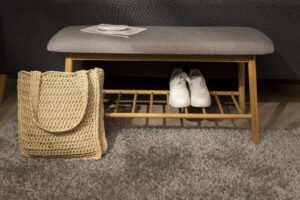Handmade rugs are more than just home decor; they are timeless pieces of art that bring texture, color, and personality to any space. With the growing demand for authentic handmade rugs, there’s an increasing interest in understanding their craftsmanship, tradition, and where to find these treasures. Choosing the right place to buy authentic rugs can make all the difference in ensuring quality, long-term value, and ethical sourcing.
This guide will walk you through what makes a rug authentic, the benefits of owning one, the top places to buy handmade rugs, and tips for choosing the perfect piece for your home.
What Makes a Rug ‘Authentic’ and ‘Handmade’?
An authentic handmade rug stands out for its uniqueness, meticulous craftsmanship, and cultural authenticity. Here’s what sets it apart:
Key Characteristics:
- Hand-knotting: This traditional technique involves meticulously tying individual knots to create intricate designs.
- Hand-tufting and Flat-weaving: Alternative crafting methods that require exceptional skill and are labor-intensive.
- Irregularities in Pattern: Slight variations in design or texture indicate that the rug was made by hand, adding to its charm and uniqueness.
Natural Materials:
- High-quality rugs are often made from materials like wool, silk, jute, and cotton, ensuring durability and a softer touch.
Indicators of Authenticity:
- Artisan-made using traditional techniques passed down through generations.
- Includes certification tags such as the GI Tag or Craftmark to verify origin and craftsmanship.
Benefits of Buying Authentic Handmade Rugs
Handmade rugs are not just investments in aesthetics; they provide several practical and ethical benefits:
- Unique and One-of-a-Kind
No two handmade rugs are identical. Each piece tells a story, reflecting the artisan’s skill and creative vision.
- Durability and Value
Handmade rugs last for generations, making them a worthwhile investment. Their value often appreciates over time, especially if maintained well.
- Support for Artisans and Weaving Communities
Purchasing handmade rugs supports local craftsmen and women, ensuring their livelihoods while sustaining traditional cultural practices.
- Eco-Friendly Production
Crafted using natural materials and processes with minimal environmental impact, these rugs are a sustainable choice for conscious buyers.
Top Places to Buy Authentic Handmade Rugs
If you’re wondering where to buy your dream rug, here are some of the top online platforms and physical markets to explore:
a. Online Platforms
- The Ambiente
Based in Delhi, India, The Ambiente blends traditional craftsmanship with modern design, offering curated collections of hand-knotted rugs. They support over 4,000 women artisans and champion ethical sourcing. Whether you want something classic or contemporary, The Ambiente creates pieces that transform spaces.
A heritage brand specializing in premium carpets, emphasizing authentic craftsmanship native to Bhadohi, dubbed the “Carpet City of India.”
- Jaipur Rugs
Known for their social impact initiatives, Jaipur Rugs focuses on empowering rural artisans and creating breathtaking designs.
- Obeetee
Specializing in luxury rugs crafted with intricate hand-knotting techniques.
- Carpet Mantra
Offers a broad selection of handmade rugs and options for customization.
- Jaypore / Fabindia
These platforms are ideal for finding smaller, handmade pieces rooted in Indian tradition.
b. Physical Markets in India
- Bhadohi (Uttar Pradesh)
Known as the “Carpet City of India,” Bhadohi is the epicenter of hand-knotted rug production.
- Jaipur (Rajasthan)
Celebrated for its vibrant colors and traditional Rajasthani artistry.
- Srinagar (Kashmir)
Renowned for exquisite Kashmiri silk and wool rugs with intricate patterns.
- Delhi’s Dilli Haat and Cottage Emporium
Government-supported craft markets showcasing high-quality, artisan-made rugs.
Things to Look for When Buying an Authentic Handmade Rug
When investing in a handmade rug, here’s how to ensure authenticity and quality:
- Check the Back of the Rug:
Visible knots indicate a hand-knotted rug, while a fabric backing suggests machine-made.
- Ask About Origin and Technique:
Understanding where and how a rug was made adds to its story and value.
- Look for Certification Tags:
Authentic pieces often come with tags that verify their origin (e.g., GI Tag, Craftmark).
- Compare Pricing to Size and Quality:
Handmade rugs are priced higher due to the labor and skill involved, but the durability and uniqueness justify the expense.
Price vs. Value: What to Expect
Why Do Handmade Rugs Cost More?
Handmade rugs require significant time, skill, and high-quality materials, which naturally increases their price. However, when you consider their lifespan and impact, they offer unmatched value.
Long-Term Investment
Unlike machine-made rugs, authentic handmade rugs can last decades and even appreciate in value, becoming cherished heirlooms.
Caring for Your Handmade Rug
To ensure your rug remains in pristine condition, follow these tips:
- Basic Maintenance:
Regularly vacuum or shake off dirt to prevent buildup.
- Professional Cleaning:
Get your rug professionally cleaned every 1–2 years to maintain its vibrancy and structure.
- Proper Storage:
If storing your rug, roll it (don’t fold), and use a cloth to protect it from dust and moisture.
Find Your Perfect Rug with The Ambiente
Authentic handmade rugs are more than just floor coverings; they represent artistry, history, and cultural tradition. They bring warmth, elegance, and personality to your space while supporting the talented artisans behind each creation.
If you’re ready to explore a collection that blends heritage with modern design, browse The Ambiente’s curated selection today. With ethical sourcing, sustainable practices, and timeless aesthetics, they’ve got the perfect rug waiting for your home.
FAQs
Are handmade rugs worth the investment?
Absolutely. Unlike mass-produced rugs, handmade options offer longevity, unique artistry, and the potential for increased value over time.
How can I tell if a rug is truly handmade?
Look for visible knots on the back, irregularities in the design, and certification tags like GI Tag or Craftmark.
Why are handmade rugs considered eco-friendly?
They are crafted using natural materials like wool, jute, and silk, with minimal environmental impact compared to synthetic, machine-made alternatives.





